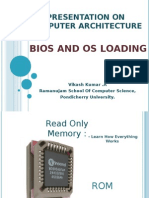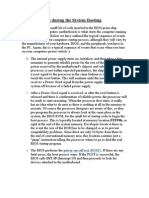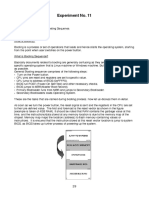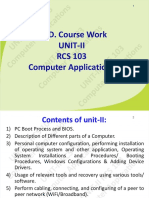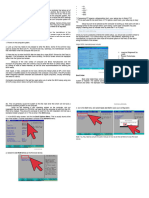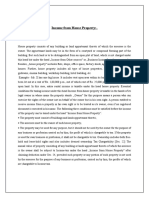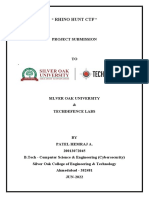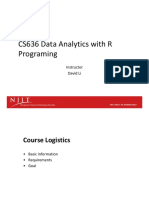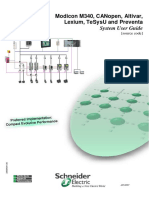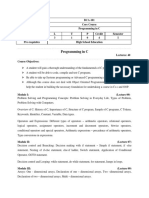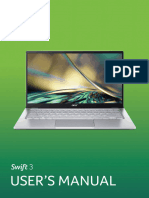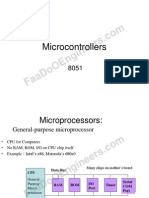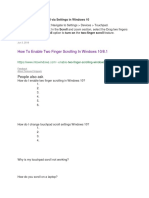Revision no.
: PPT/2K403/02
Booting Sequence
� Revision no.: PPT/2K403/02
BIOS and POST
BIOS
It is the software that controls the flow of information among the
various components of the computer and handles information
regarding the various hardware present in the system.
It is normally programmed on a ROM chip.
POST
These are testing routines that are stored in ROM BIOS which
bring about PC initialization.
When POST detects an error either from the keyboard, display or
memory or various components it produces an error warning in
the form of a message or beeps.
CMS INSTITUTE, 2004. All rights reserved. No part of this material may be reproduced, stored or emailed without the prior permission of Programme Director, CMS Institute
� Revision no.: PPT/2K403/02
Booting Sequence
Internal power supply turns on and will generate a power good
signal if reliable power is present and then will generate a reset
signal to the processor.
Processor is pre-programmed for BIOS boot program at
FFFF0h, which contains a jump instruction at the end of the
conventional memory to POST program.
BIOS looks for built-in BIOS of video card normally found at
C000h, thus initializing the video card and displaying
information on screen.
CMS INSTITUTE, 2004. All rights reserved. No part of this material may be reproduced, stored or emailed without the prior permission of Programme Director, CMS Institute
� Revision no.: PPT/2K403/02
Booting Sequence (contd.)
BIOS then checks BIOS of IDE/ATA hard disk which is
normally found at C800h and execute it.
BIOS then tests the memory by writing data to the chips and
then the data it had sent to the chips.
BIOS performs a system inventory by detecting the parameters
for devices like memory timing, hard disk access modes,
labeling logical devices, etc.
If BIOS supports Plug and Play, it will detect and configure
Plug and Play devices.
CMS INSTITUTE, 2004. All rights reserved. No part of this material may be reproduced, stored or emailed without the prior permission of Programme Director, CMS Institute
� Revision no.: PPT/2K403/02
Booting Sequence (contd.)
BIOS then displays a summary screen about the systems
configuration.
If any fatal errors are encountered during POST the boot
process stops.
BIOS then begins the search for a drive to boot from.
BIOS looks for boot information to start an operating system
boot process at the boot sector normally at cylinder 0, head 0
and sector 1 on the hard disk or floppy disk.
BIOS starts the booting process using the information in the
boot sector.
CMS INSTITUTE, 2004. All rights reserved. No part of this material may be reproduced, stored or emailed without the prior permission of Programme Director, CMS Institute
� Revision no.: PPT/2K403/02
Booting Sequence (contd.)
If boot device is not found, the system will normally display an
error message and freeze up the system.
When the machine is rebooted using Ctrl+Alt+Del, it is called
as warm boot wherein POST is skipped.
CMS INSTITUTE, 2004. All rights reserved. No part of this material may be reproduced, stored or emailed without the prior permission of Programme Director, CMS Institute
� Revision no.: PPT/2K403/02
DOS Booting
After POST, boot program of BIOS chip checks the boot device
for the system files I.e. IO.SYS and MSDOS.SYS and if it is not
present then it generates an error message.
BIOS then passes control to the boot record which constitutes
the boot devices first sector being copied into specific
locations of RAM.
Boot record then loads IO.SYS into RAM which contains a
routine SYSINIT which manages the rest of boot process.
SYSINIT then loads MSDOS.SYS into RAM which works with
BIOS to manage files,execute programs and respond to
hardware signals.
CMS INSTITUTE, 2004. All rights reserved. No part of this material may be reproduced, stored or emailed without the prior permission of Programme Director, CMS Institute
� Revision no.: PPT/2K403/02
DOS Booting (contd.)
SYSINIT searches a file CONFIG.SYS and if it exists, SYSINIT
tells MSDOS.SYS executes commands in CONFIG.SYS.
CONFIG.SYS contain instructions to load device drivers which
are files containing code that extend the capabilities of BIOS to
control hardware.
SYSINIT then instructs MSDOS.SYS to load COMMAND.COM
PC is now fully booted and ready to be used.
CMS INSTITUTE, 2004. All rights reserved. No part of this material may be reproduced, stored or emailed without the prior permission of Programme Director, CMS Institute
� Revision no.: PPT/2K403/02
BIOS Startup Screen
Typical BIOS start up screen contains
BIOS Manufacturer and Version Number
BIOS Date
Setup Program Key
Key to press to enter BIOS setup program.
System Logo
Logo of BIOS or Motherboard or PC maker
Energy Star Logo
For BIOS supporting Energy Star standard
BIOS Serial Number
Helpful to determine specific motherboard and BIOS version
CMS INSTITUTE, 2004. All rights reserved. No part of this material may be reproduced, stored or emailed without the prior permission of Programme Director, CMS Institute
� Revision no.: PPT/2K403/02
Design & Published by:
CMS Institute, Design & Development Centre, CMS House, Plot No. 91, Street No.7,
MIDC, Marol, Andheri (E), Mumbai 400093, Tel: 91-22-28216511, 28329198
Email: courseware.inst@cmail.cms.co.in
www.cmsinstitute.co.in
CMS INSTITUTE, 2004. All rights reserved. No part of this material may be reproduced, stored or emailed without the prior permission of Programme Director, CMS Institute


















